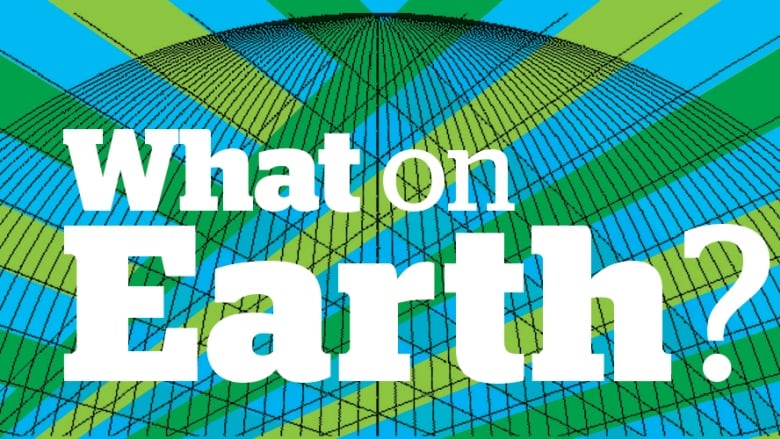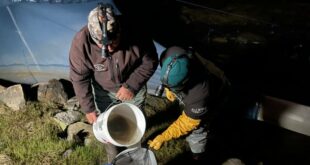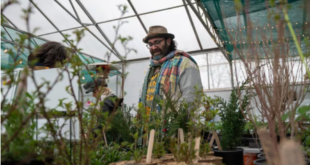Also: What’s a rain garden?

Our planet is changing. So is our journalism. This weekly newsletter is part of a CBC News initiative entitled “Our Changing Planet” to show and explain the effects of climate change. Keep up with the latest news on our Climate and Environment page.
Sign up here to get this newsletter in your inbox every Thursday.
This week:
- What climate activism means to 3 generations of this Indigenous family
- Rain gardens: An elegant way to manage water
- How hard is it to get EV charging stations into residential buildings?
What climate activism means to 3 generations of this Indigenous family

As a record-breaking wildfire season continues to ravage parts of Canada, countless people are grappling with the immediate effects on air quality, health and property.
Margaret Kappo, from Sturgeon Lake Cree Nation Treaty 8 territory, is one of 14,000 people in Alberta who were forced to evacuate their homes, and is still coming to grips with how much her life has changed.
“I thought, ‘Oh, it’ll be just a temporary thing and I’ll be able to go home,'” said Kappo in an interview with What On Earth host Laura Lynch. But six weeks later, she’s still waiting to return.
After wildfire swept through her community, Kappo travelled back to see the destruction first-hand. She described it as “desolate, barren and black” and compared it to Mordor, the volcanic plain of Middle-earth in The Lord of the Rings.
“You go to this place of, ‘How is this my life?'” Kappo said. “It’s still not totally sinking in that this is the way it is now for me here.”
It’s a difficult story for Kappo to recount, and equally difficult for family members to hear. She and her kin have always understood the need to care for the land, and yet the wildfires this spring have shown the sheer ferocity of human-made climate change.
Stories like Kappo’s are becoming more common in Indigenous communities, which has led her and family members to reflect on the notion of environmental stewardship.
What On Earth‘s interview with Kappo also included her daughter, Tanya, and her grandson, Mihskakwan James Harper. During the conversation, Tanya Kappo, a lawyer and Indigenous rights activist based in Winnipeg, admitted that climate activism wasn’t a particular revelation for her.
“It’s not a conscious decision in the sense of one day I’m waking up and I’m going to say, ‘OK, this is what I’m going to do. I’m going to go and save the world and protect the environment and everything like that,'” said Kappo, who served on the board of Greenpeace Canada, co-founded the Idle No More movement and is currently enrolled in a graduate program at the University of Arizona in Indigenous peoples law and policy. “It’s more been a matter of how I was raised.”
Tanya Kappo referred to foundational Cree teachings, specifically the concept of Wahkôhtowin. It’s a Cree word that literally translates to “kinship” and denotes the interconnectedness of everything — people and nature. Her son picked up on this thread.
Harper, who works in business development for the Toronto-based energy solutions company NRStor, thinks back fondly on conversations he has had with his grandmother over tea and bannock. When he told her a few years ago that he had plans to pursue a master’s degree in renewable energy, Harper was moved by her philosophical take on the concept of energy.
“In Cree, you said kahkinaw ayawin,” Harper noted, addressing his grandmother. “Literally translating to ‘it’s all around us.’ You were describing energy way beyond the physical sense — it’s metaphysical. It is the thing that connects us with the world around us and we have to be intentional in those relationships as well.”
Harper said he uses teachings like this to communicate to other young people that they have a responsibility to act now and fast — not just for the planet but to honour past, present and future generations.
“It’s beautiful to hear it,” Margaret Kappo said. “We’re going through this major tough time. But it’s very heartening to know that the baton keeps on going, the flame carries on forward and James is taking it further, beyond here or beyond Canada, where he goes, and spreading the word that way. So it’s really an amazing gift.”
— Dannielle Piper
Old issues of What on Earth? are here. The CBC News climate page is here.
Watch the CBC video series Planet Wonder featuring our colleague Johanna Wagstaffe here.
Reader feedback
Last week, we published a letter from reader Joanne Moyer in which she said, “In the morning, on the local CBC Radio show, there are regular reports on sports, economics and other things like that. Surely, given the state of today’s environment, we should also be getting regular environmental/climate reports in the same way.”
Many What on Earth? readers responded positively to this suggestion, including Gaynette Friesen:
“I wanted to add my voice to that. Please. We rely on the CBC to inform us locally, nationally and globally, unlike news sources south of us. I also teach environmental science but at high school, and find your reports very useful. Keep up the great work, and please expand!”
We wanted to let you know that we have taken the suggestion to CBC managers, and will keep you posted on the progress.
Write us at whatonearth@cbc.ca. Have a compelling personal story about climate change you want to share with CBC News? Pitch a First Person column here.
The Big Picture: Rain gardens
After seeing Laura Lynch’s piece last week on clam gardens on the B.C. coast, reader Deborah Jones wrote in to ask if we’ve done anything on a related topic of water management: rain gardens. The answer is no, so we’re tackling it here.
A rain garden is a landscaped part of a yard that collects stormwater (from rain or snow). It’s largely a mechanism to reduce flooding, although it also helps keep pollutants out of the drainage system. Created by a depression in the yard with loose, deep soil, a rain garden absorbs water from your roof, grass or driveway and prevents it from getting into the storm drainage system (and, consequently, waterways).
The diagram below, taken from a brochure published by the Toronto and Region Conservation Authority, demonstrates one option, although there are many variations that can have the same effect. If you’re looking to build a rain garden, here is some inspiration.
The main takeaway for aspiring rain gardeners is that whatever style you decide on, the structure should be in a low-lying area of your yard and at least three metres from your home or a neighbouring property. Angling a downspout toward the rain garden will also ensure the water goes where it’s intended.

Hot and bothered: Provocative ideas from around the web
- Had a bumpy flight? Severe turbulence increased 55 per cent between 1979 and 2020 on a typical North Atlantic route, researchers say. And you can blame climate change.
- Many fossil fuel companies are setting net-zero goals, but a new report finds many of them don’t include emissions from burning the fuels and many don’t set short-term goals, making them “largely meaningless.”
- Canada’s strategy for fighting wildfires is based on sharing firefighting resources, such as planes. CBC took a closer look at the country’s water bomber fleet and found that the strategy might not work well in Canada’s increasingly fiery future.
- In Framingham, Mass., the local gas utility, Eversource, is building a shared underground heating loop to provide geothermal (geoexchange) heating for a whole neighbourhood. It will connect 40 buildings, including low-income apartments, single-family homes, small businesses and the local fire station. Each property owner just needs to buy a heat pump to connect.
How hard is it to get EV charging stations into residential buildings?

When Mathieu Gosbee moved from his detached home in midtown Toronto to a condominium downtown, he was able to bring all his belongings but one: the device that charges his electric car.
The 38-year-old software developer purchased his Hyundai Kona electric vehicle (EV) two years ago, and personally installed a Level 2 charger in the garage of his house for about $400.
The condo board said a single charger would cost $5,000 to $10,000 to install, which seems quite expensive to Gosbee — but he and other EV owners in his building are desperate.
“I want to have the convenience of charging at home — it’s part of the reason I bought my car in the first place,” he said.
If approved, it’s still going to take another year for the charger to be installed at the condo. In the meantime, Gosbee (shown in the photo above) has to rely on public charging stations. But there aren’t that many public stations around his condo — and when he does find one, it’s often occupied by another EV owner, if it isn’t broken.
“I’m just really feeling the pressure of charging now,” he said.
People like Gosbee are sometimes called “garage orphans,” because they don’t have driveways, designated parking spots or easy access to private charging options. But experts say there are ways to address this issue.
“It’s absolutely possible to get charging infrastructure caught up, but it requires some effort,” said Ian Klesmer, a spokesperson for the Atmospheric Fund, which finances initiatives to reduce carbon emissions and other pollution.
The popularity of EVs is growing in Canada. According toStatistics Canada, 86,032 electric vehicles are currently on the road, and new zero-emission vehicle registrations increased by 43.2 per cent year over year in the third quarter of 2022.
But charging infrastructure lags behind and tends to be concentrated in newer buildings and wealthier areas.
Level 1 chargers, the slowest type, use a common residential 120-volt AC outlet — what you use to charge your phone. It takes about 30 hours to fully charge a vehicle at Level 1. Klesmer said many owners who don’t use their EVs as often are content to rely on this type of charger.
Most public and private chargers tend to be Level 2, which can take six to seven hours to charge a regular EV; they typically cost about a dollar to $2.50 an hour (although some are also free). Level 3 chargers, also known as DC fast chargers, are the fastest and can charge an EV from empty to 80 per cent in 30 to 45 minutes. These usually cost about $20 per hour.
Public chargers are typically found outside shopping malls, theatres and other public areas, and are usually installed and managed by private companies and sometimes funded by the government.
While it would be cheapest to install Level 1 chargers in parking garages, Klesmer said it would be the least practical and efficient option.
There are a few ways to solve the larger problem of residential charging, he said, starting with landlords and condo boards taking advantage of government incentive programs.
Klesmer noted that multi-family buildings like Gosbee’s can tapfederal government funding — like the Zero Emission Vehicle Infrastructure Program — to cover up to half of the cost of installation for up to 20 chargers.
This program only covers the installation costs for charging stations, but there are similar provincially funded programs that are more “holistic,” said Klesmer. For example, B.C’s “three-pronged”incentive program includes funding for an initial assessment, the actual charger and the installation.
Part of the broader transition to electric vehicles is taking a different approach to “filling up,” said Rachel Doran, director of policy and strategy at Clean Energy Canada.
Instead of doing it in one go, like at a conventional gas station, she encourages EV owners to educate themselves about the various charging options nearby and thinking about charging according to what they need in the short term, which might be half a tank or less.
Even so, there are challenges. As of 2023, Canada had about 19 EVs for every publicly available charger, according to theInternational Energy Agency. Compare that to South Korea, where there were around two EVs per public charger.
“Insufficient” charging infrastructure, along with low demand, was one of the reasons Canada ranked eighth among the 10 leading auto markets in a 2021 EV readinessanalysis.
“While [an EV] definitely has its advantages, it makes sense to question why a consumer would want to buy a vehicle that takes so much effort to even get started,” Klesmer said.
While he hopes the infrastructure keeps pace with the rising uptake of EVs, Klesmer also noted that if more buildings get their act together when it comes to charging stations, there will be less need for public ones.
“If we could figure out how to get charging to [building-dwellers] at home, then it would be much more affordable for the homeowners, much more convenient to be able to charge at home, and would require much less public investment in building out a public charging infrastructure.”
— Prapti Bamaniya
Stay in touch!
Are there issues you’d like us to cover? Questions you want answered? Do you just want to share a kind word? We’d love to hear from you. Email us at whatonearth@cbc.ca.
Editor: Andre Mayer | Logo design: Sködt McNalty
*****
Credit belongs to : www.cbc.ca
 Atin Ito First Filipino Community Newspaper in Ontario
Atin Ito First Filipino Community Newspaper in Ontario






